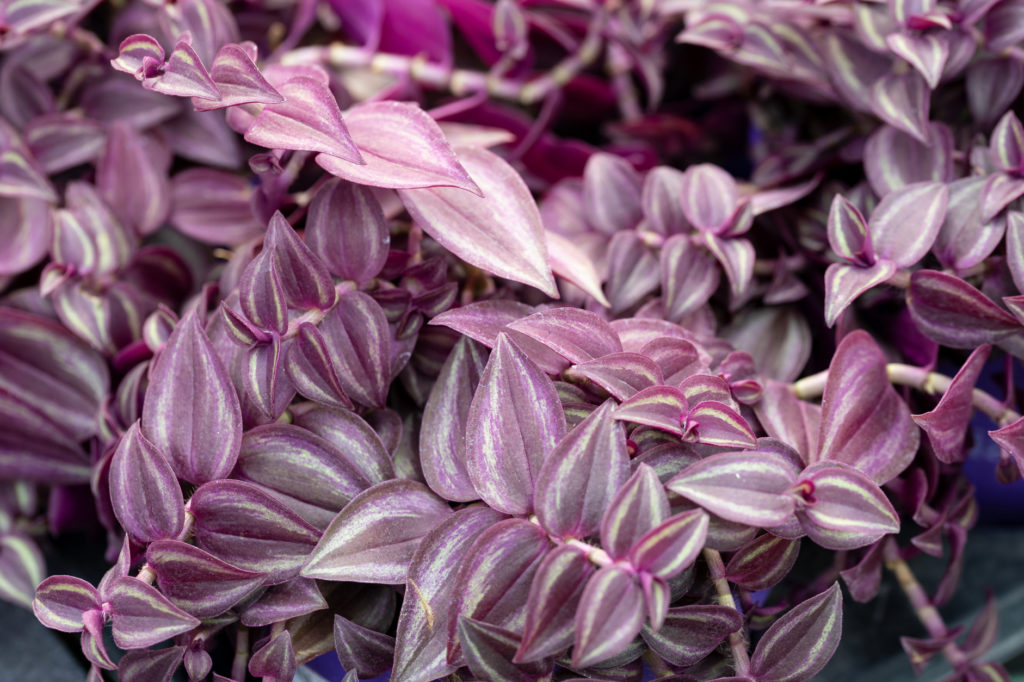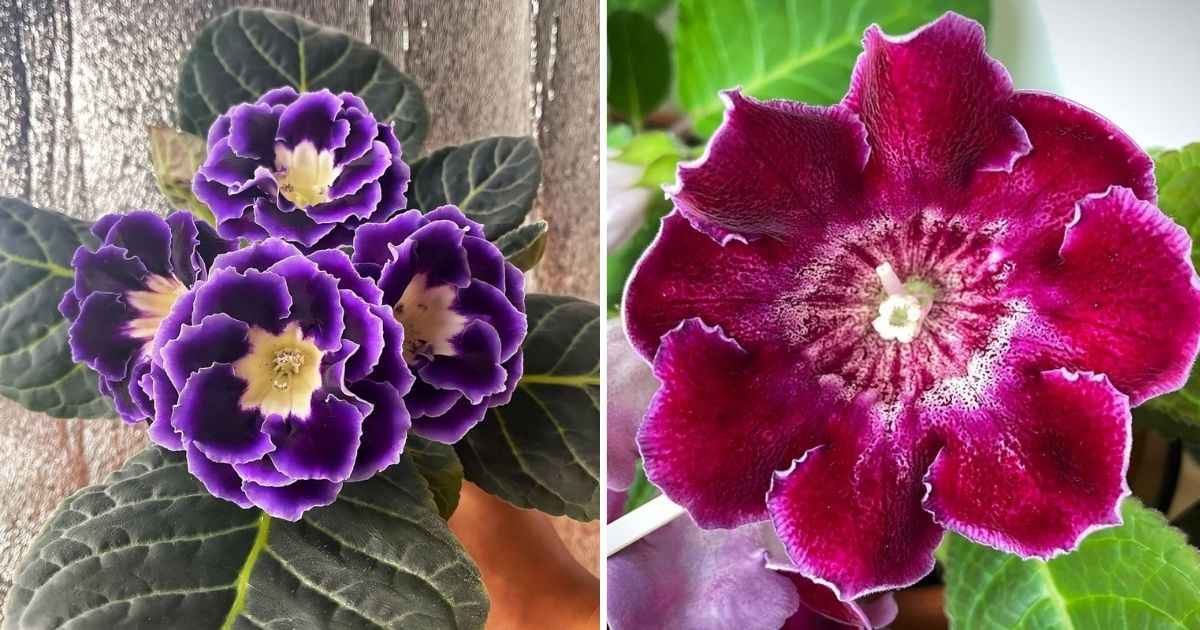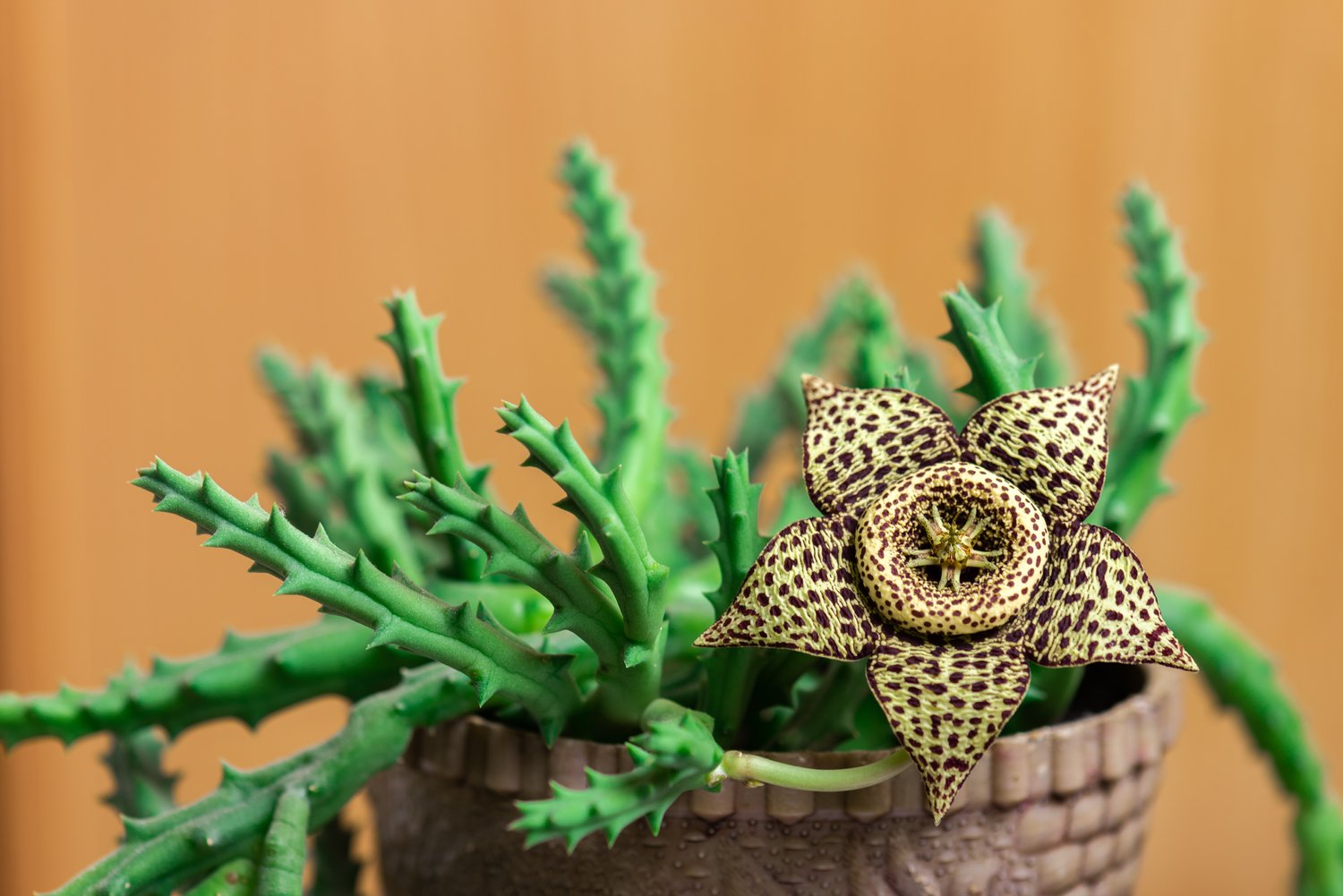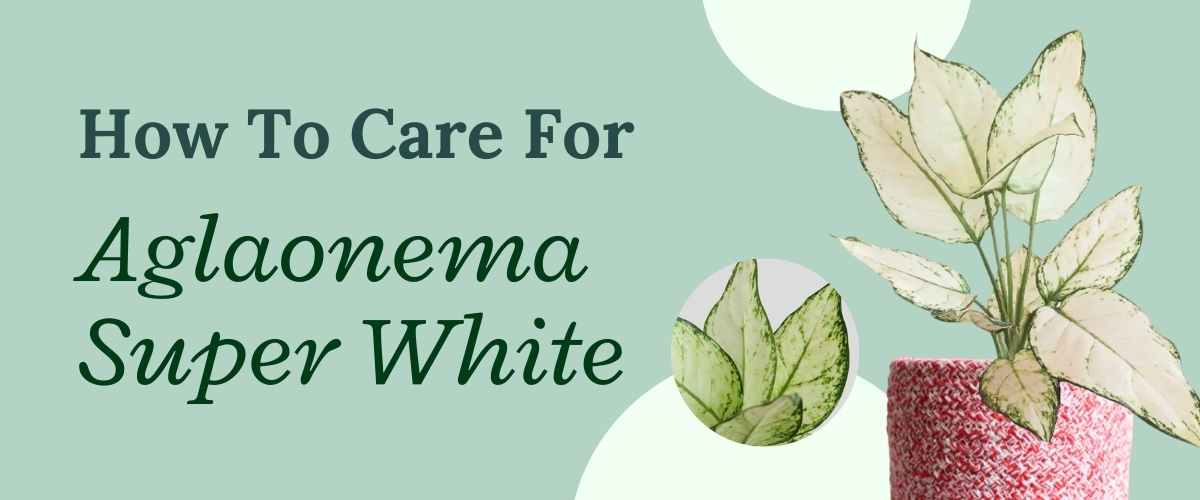Houseplants are intended to brighten up a home, so what better way to do so than with these purple-leaved beauties?
Purple is not necessarily a colour that occurs in nature with too much frequency, but when it does, you can be sure that the outcome is an eye-catching one.
That’s why we’re following on from our list of outdoor purple-leaved plants with this catalogue of similarly coloured houseplants – for a superb, sure-fire way to liven up your home’s interior décor.
Whether it’s foliage awash with the deepest shades of purple, variegated leaves that alternate between purple and green or more subtle tinges, fringes and flecks of purple on your plant, we’ve got you covered.
Most of the options below are fairly easy to cultivate, but all of them are extremely easy on the eye.
1) Rose-Painted Calathea ‘Dottie’
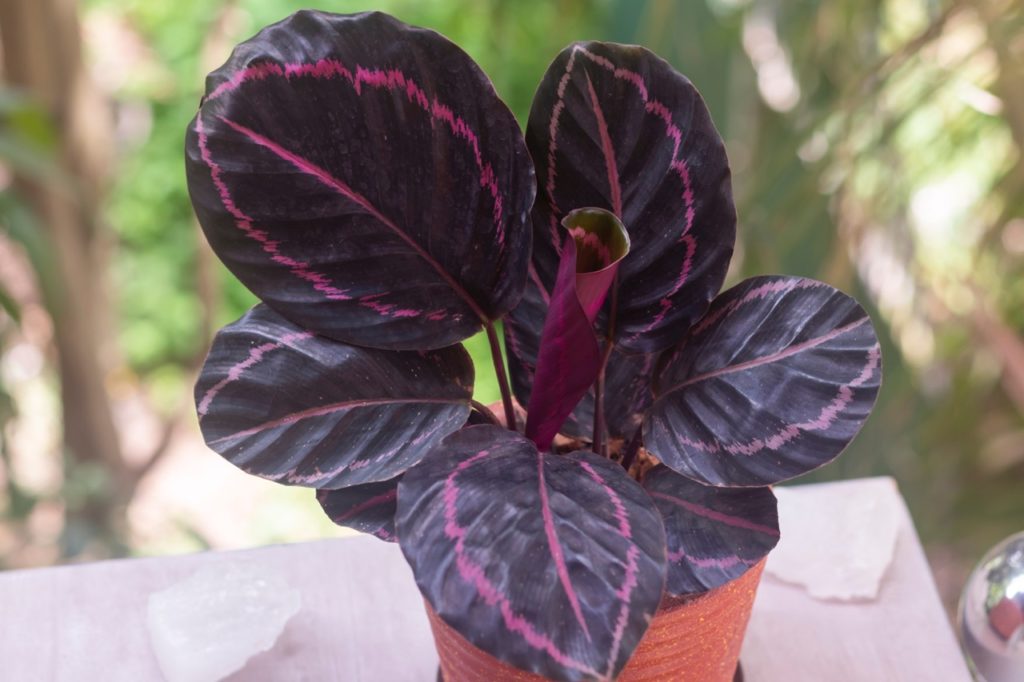 BOTANICAL NAME: Goeppertia roseopicta ‘Dottie’ HARDINESS RATING: H1A FLOWERS: purple and white FLOWERING SEASON(S): summer SUNLIGHT: part shade
BOTANICAL NAME: Goeppertia roseopicta ‘Dottie’ HARDINESS RATING: H1A FLOWERS: purple and white FLOWERING SEASON(S): summer SUNLIGHT: part shade
Native to Brazil, this broad-leaved prayer plant opens up its foliage to the heavens.
The topmost side features starkly-veined dark green leaves with a vibrant pink centre, while their underside is a rich purple that’s more visible at night as they close in on themselves.
Due to its tropical origins, ‘Dottie’ prefers bright but indirect sunlight, so choose a windowsill in an appropriate location; the darker the leaves, the more UV it will need.
It needs constant moisture but hates saturated soil, so water it frequently but sparingly.
2) Echeveria ‘Purple Pearl’
 BOTANICAL NAME: Echeveria ‘Purple Pearl’ HARDINESS RATING: H2 FLOWERS: pink FLOWERING SEASON(S): summer SUNLIGHT: full sun
BOTANICAL NAME: Echeveria ‘Purple Pearl’ HARDINESS RATING: H2 FLOWERS: pink FLOWERING SEASON(S): summer SUNLIGHT: full sun
With its small but fleshy leaves and delicately purple tones, ‘Purple Pearl’ is an absolute treat to behold, especially in springtime, when the dainty coral-coloured blooms complement the rest of its visual palette.
Like most succulents, it prefers full sun, can’t handle colder temperatures and will benefit most from soaking it thoroughly and then letting it dry out completely.
“Echeveria will need full sun or it might start to etiolate (stretching to reach more light),” shares Master Horticulturist Colin Skelly.
“You also might need to rotate the pot to achieve even growth.
In full summer sun, the colours will darken substantially as a stress response and in winter it will become a greener hue as it enters its active growing phase.”
Capable of reaching 30cm in height, it’s a breathtakingly beautiful yet compact houseplant to add to your collection.
3) Oxalis ‘Iron Cross’
 BOTANICAL NAME: Oxalis tetraphylla ‘Iron Cross’ HARDINESS RATING: H4 FLOWERS: pink FLOWERING SEASON(S): spring / summer SUNLIGHT: full sun
BOTANICAL NAME: Oxalis tetraphylla ‘Iron Cross’ HARDINESS RATING: H4 FLOWERS: pink FLOWERING SEASON(S): spring / summer SUNLIGHT: full sun
The dark purple triangles at the centre of the four-leaved clover-like foliage give this perennial bulb its nickname since it resembles the Iron Cross of Prussia.1Begonia masoniana (Iron Cross Begonia). (n.d.). North Carolina Extension Gardener Plant Toolbox. Retrieved March 17, 2023, from https://plants.ces.ncsu.edu/plants/begonia-masoniana/
From June to August, you can enjoy the additional appeal of its attractive flowers, which are either red or pink depending on the type of soil in which it’s grown.
Another point in the plus column for the Iron Cross is its versatility.
It’ll thrive just as well in full sun as it will in the shade and can adapt to most soil types.
Its watering demands are entirely reasonable, making it an easy-to-care-for houseplant.
4) Moses In The Cradle
 BOTANICAL NAME: Tradescantia spathacea HARDINESS RATING: H1B FLOWERS: white FLOWERING SEASON(S): spring / summer / autumn / winter SUNLIGHT: full sun / part shade
BOTANICAL NAME: Tradescantia spathacea HARDINESS RATING: H1B FLOWERS: white FLOWERING SEASON(S): spring / summer / autumn / winter SUNLIGHT: full sun / part shade
A member of the Tradescantia family, Moses in the cradle is characterised by its lengthy lance-shaped leaves, which blend green, red and purple in a mesmerising mix.
Devastatingly attractive yet diminutive, the plant rarely exceeds 30cm in height.
Its growing demands are modest, though it does prefer stronger sunlight and a stable temperature if possible.
It can flower at any time of the year, adding another string to its aesthetic bow.
5) Painted Nettle
 BOTANICAL NAME: Coleus scutellarioides HARDINESS RATING: H1C FLOWERS: blue FLOWERING SEASON(S): spring / summer / autumn SUNLIGHT: full sun
BOTANICAL NAME: Coleus scutellarioides HARDINESS RATING: H1C FLOWERS: blue FLOWERING SEASON(S): spring / summer / autumn SUNLIGHT: full sun
Painted nettles come in a virtually limitless number of varieties.
Although it does bear flowers, it’s the foliage which is the real attraction here, as the velvety leaves are lovely to the touch, while the range of variegated colours and patterns make it a delight to behold too.
For best results, place your painted nettles in direct sunlight, since their leaves will fade in colour if they are deprived of sunlight.
Water evenly, prune regularly and ensure good aeration of the soil to keep your specimen healthy and happy.
6) Persian Shield
 BOTANICAL NAME: Strobilanthes dyeriana HARDINESS RATING: H1B FLOWERS: blue FLOWERING SEASON(S): autumn SUNLIGHT: full sun / part shade
BOTANICAL NAME: Strobilanthes dyeriana HARDINESS RATING: H1B FLOWERS: blue FLOWERING SEASON(S): autumn SUNLIGHT: full sun / part shade
The name of this exotic specimen is something of a misnomer; the leaves are perhaps more reminiscent of arrowheads than shields, while it originally hails from Myanmar, not Persia.2Strobilanthes dyerianus. (n.d.). Missouri Botanical Garden. Retrieved March 17, 2023, from https://www.missouribotanicalgarden.org/PlantFinder/PlantFinderDetails.aspx?taxonid=292523&isprofile=0&basic=%25
Nonetheless, the purplish iridescence of its foliage is one of the most attractive qualities of any option on this list.
In its youth, the Persian shield will maintain vibrancy and vitality in its leaves but expect this to soften and dull over the years.
You can prolong its lustre as long as possible by giving it what it wants, namely plenty of sunshine, warmth and water.
7) Sedum ‘Purple Emperor’
 BOTANICAL NAME: Sedum telephium ‘Purple Emperor’ HARDINESS RATING: H7 FLOWERS: pink FLOWERING SEASON(S): summer SUNLIGHT: full sun
BOTANICAL NAME: Sedum telephium ‘Purple Emperor’ HARDINESS RATING: H7 FLOWERS: pink FLOWERING SEASON(S): summer SUNLIGHT: full sun
‘Purple Emperor’ belongs to the sedum family, which is also known as stonecrops due to their ability to thrive in poor soils populated by pebbles and rocks.
This particular specimen is one of the most eye-catching, boasting dark purple, almost black leaves topped by towering stems and small clusters of bright pink flowers.
Purple emperors do just as well outdoors as inside, but in both situations, they’ll prefer sandy or rocky soil.
You can water them more often in their first year to ensure they become fully established, but after that, they’ll require less frequent irrigation.
8) Purple-Heart Spiderwort
 BOTANICAL NAME: Tradescantia pallida HARDINESS RATING: H1C SUNLIGHT: full sun / part shade
BOTANICAL NAME: Tradescantia pallida HARDINESS RATING: H1C SUNLIGHT: full sun / part shade
Another member of the Tradescantia family, ‘Purple Heart’ is characterised by the deep burgundy shades of both its stems and its slender, cupped leaves.
While it does produce uniquely attractive clusters of flowers in a range of pinky-purple colours, it’s the foliage that’s the main event.
A drought-tolerant species, this plant will survive without too much in the way of maintenance.
‘Purple Heart’ is particularly notable for its profusion of leaves, which look especially attractive when cascading over the rim of a hanging basket.
9) Velvet Plant ‘Purple Passion’
 BOTANICAL NAME: Gynura aurantiaca ‘Purple Passion’ HARDINESS RATING: H1B FLOWERS: purple and yellow FLOWERING SEASON(S): winter SUNLIGHT: part shade
BOTANICAL NAME: Gynura aurantiaca ‘Purple Passion’ HARDINESS RATING: H1B FLOWERS: purple and yellow FLOWERING SEASON(S): winter SUNLIGHT: part shade
For a more understated touch of purple, this vine plant is an excellent addition to any home.
Its stems and the undersides of its leaves are a deep dark purple, while its bright green foliage is fringed by a purplish tinge and populated by soft, purple hairs.
That velvety texture makes ‘Purple Passion’ a pleasure to touch as well as to observe, while its ease of cultivation means it’s ideal for novice or busy houseplant enthusiasts.
Keep it well-watered (but not overwatered, since it’s highly prone to root rot) and it’ll remain happy enough.
10) Purple Shamrock
 BOTANICAL NAME: Oxalis triangularis HARDINESS RATING: H3 FLOWERS: pink and white FLOWERING SEASON(S): summer / autumn SUNLIGHT: part shade
BOTANICAL NAME: Oxalis triangularis HARDINESS RATING: H3 FLOWERS: pink and white FLOWERING SEASON(S): summer / autumn SUNLIGHT: part shade
This exquisite perennial is a close relative of the aforementioned Iron cross and gains its name from the trio of triangular leaves which adorn each stem.
Exceedingly dark in hue, its purple foliage is almost black in colour, making it a dramatic addition to your indoor display.
Those dark tones are perfectly set off by its white or lavender blooms, which can appear at pretty much any time of the year.
The purple shamrock’s leaves neatly fold up at night like an umbrella, but it’ll spring back with renewed vigour the following morning without fail.
However, those same fast-growing properties make it ideal as a trailing houseplant for a hanging basket inside your home, as its zebra-like leaves cascade over the sides of its container attractively.
